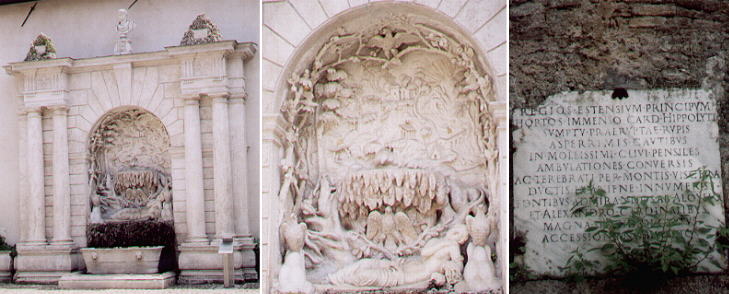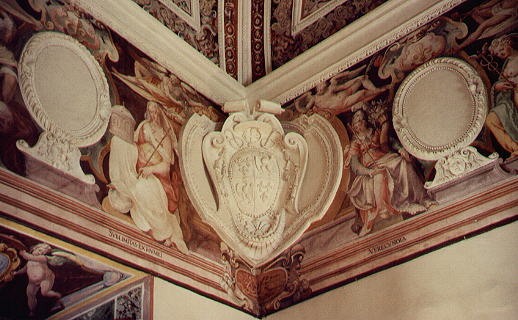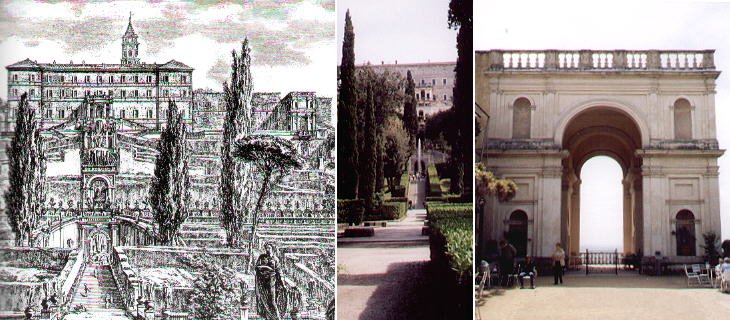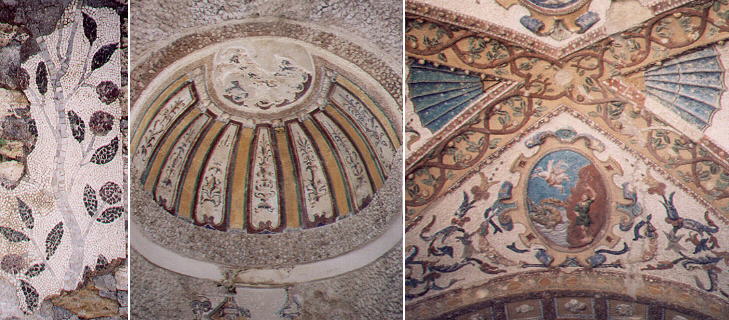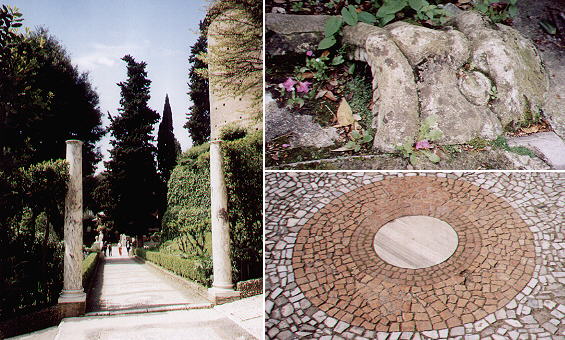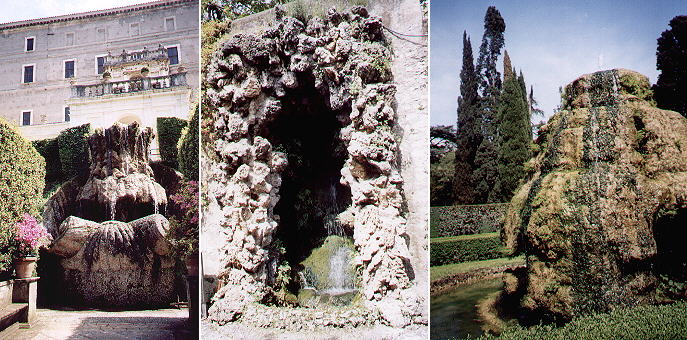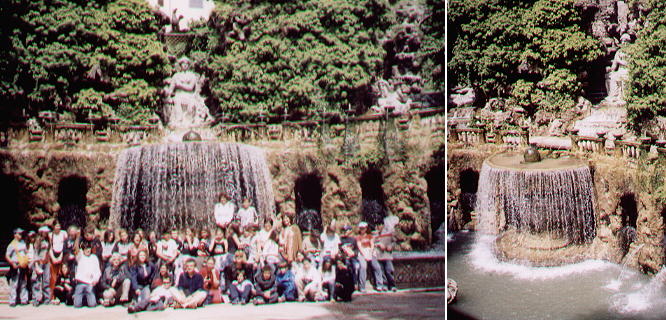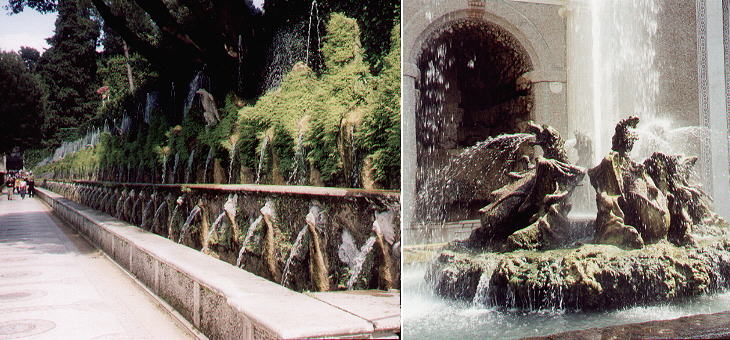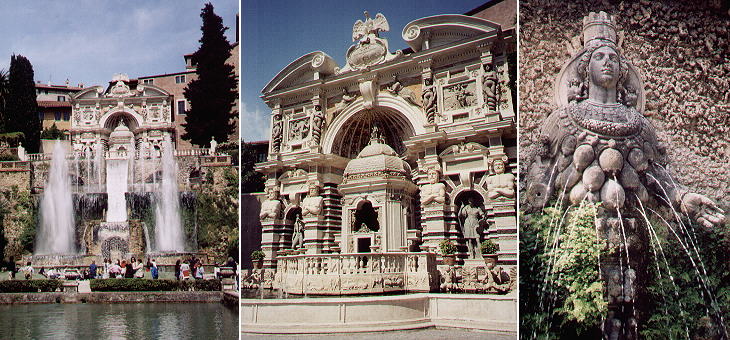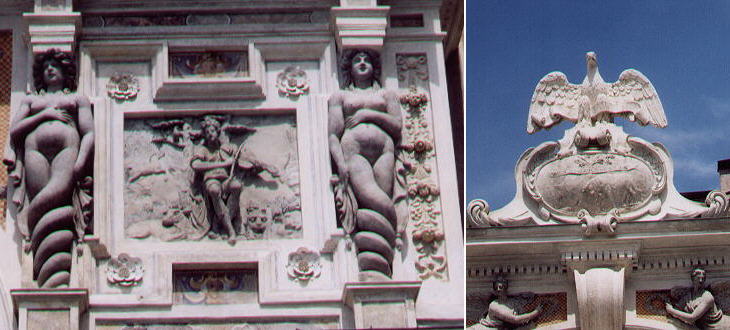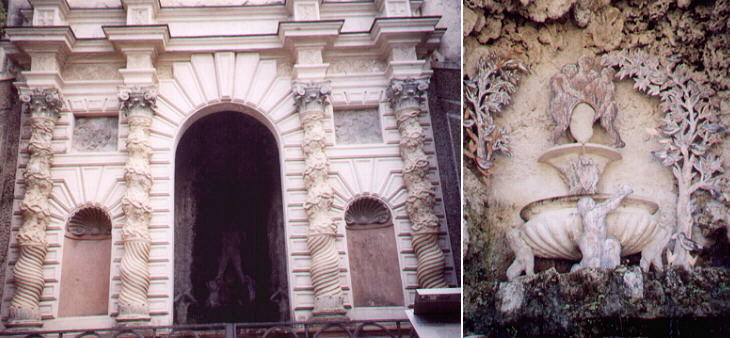  Giuseppe Vasi's Digression - Tivoli - part three: Villa d'Este
Cardinal Ippolito d'Este was born in Ferrara in 1509: his father Alfonso I d'Este, duke of Ferrara, Modena and Reggio had married Lucrezia Borgia, daughter of Pope Alexander VI
and Vannozza Cattanei; as he was a cadet he followed the steps of his uncle Ippolito who had been appointed cardinal at the age of
14. The nephew was appointed cardinal (so he is more properly called Cardinal Ippolito II) in 1539 and in 1550 he became governor of Tivoli. In more than one conclave he
entṛ papa, usć cardinale entered pope and came out cardinal: he was supported by the King of France, but the Spanish Emperor
vetoed his election.
A fountain in the large courtyard which leads to the casino is a sort of manifesto of the villa. It is framed by an arch of classical design. A Roman sarcophagus and a statue of Venus establish a link between the villa and the ancient world. The eagles are a heraldic symbol of the Este. Branches of trees with apples mean that the visitor is about to enter the orchard of the Hesperides, the nymphs who guarded the golden apple-tree, the wedding gift of Mother Earth to Hera. According to the myth that garden lay on the slopes of Mount Atlas. Similarly Villa d'Este occupies the slope of a hill. The relief above the statue of Venus is a metaphor of the works done to control the flow of water and to terrace the hill. An inscription in the gardens describes the amplitude of this effort. The image used as background for this page shows a column decorated with branches of golden apples.
The decoration of the casino is generally light and of a profane nature with many coats of arms of Cardinal Ippolito. There are several fountains inside the building in a sort of anticipation of those in the gardens.
Villa d'Este was designed by Pirro Ligorio, an architect who had a reputation for his knowledge of the ancient world and who later on designed Casino di Papa Pio IV. A perspectively arranged series of alleys and fountains frame the view of the casino. Villa d'Este is not oriented towards Rome, so a large loggia on its western side provides a sort of balcony on the plain and the Eternal City.
The gardens have several grottoes, artificial caves which provided a fresh haven on the hottest days. The decoration of the grotto is called tartar because it resembles the incrustations formed by acid potassium tartrate on the sides of casks after the fermentation of wine. A famous example of this kind of decoration can be seen in the Boboli gardens in Florence. The grottoes were not aimed at recreating a real cave and they were decorated with paintings and mosaics.
For sure both Cardinal Ippolito and Pirro Ligorio had in mind the Villa the Emperor Hadrian had built on the plains some 3 miles from Tivoli when they designed Villa d'Este. Although the works of art the Cardinal took from Hadrian's Villa to adorn his own villa are now scattered in museums and galleries, columns and discs of columns coming from Hadrian's Villa still embellish the alleys of Villa d'Este. The image above shows also a bizarre detail at the end of a small fountain.
Many fountains have the appearance of natural rocks, but they often hide a more complex design or meaning. Villa d'Este was completed or modified by the heirs of Cardinal Ippolito and Gian Lorenzo Bernini designed the first fountain shown above where the upper part seems to be just a rock and only when the viewer looks at the volute below, he understands he is looking at a Baroque fountain. The last fountain shown above again at first seems to be a natural rock, while it was designed having in mind the "sweating" Roman fountains, where water flowed on the surface as sweat does on the skin. The cypress shown behind the fountain is one of the two surviving cypresses of the initial plantation. You may wish to read what Henry James wrote about these mighty cypresses or William Dean Howells' account of his visit to Villa d'Este in 1908.
Nymphs and gods populate most of the fountains of Villa d'Este and this large fountain has the oval shape of a Roman nymphaeum. It was possible to walk behind the waterfall in a corridor linking a series of caves. Another fountain, Rometta, recreated Ancient Rome including a reproduction of Isola Tiberina.
The fountains show the engineering skills of the technicians who assisted Pirro Ligorio and Cardinal Ippolito. They were able to perfectly control the pressure of the various jets, without the machinery we are accustomed to using today. In addition to pleasing the eye, the fountains had a musical sound and to this purpose fountains like Fontana delle Cento Cannelle (the hundred fountains) gave better results than Fontana dell''Ovato. Franz Liszt lived for many years in Villa d'Este, then a possession of the Austrian Emperor, and he wrote one of his most popular pieces on the different sounds of the fountains (Les Jeux d'Eau à la Villa d'Este). Fontana dei Draghi was dedicated after the death of Cardinal Ippolito to Pope Gregorius XIII who had visited Villa d'Este. In origin the fountain should have been dedicated to Heracles and more specifically to his second labour: the destruction of Hydra, a monster which had eight or nine snaky heads: the fountain was to be completed with a statue of Heracles, but in the last decades of the XVIth century the passion for the pagan gods which had characterized the previous one hundred years was starting to be challenged: so the heads of Hydra were rearranged to look like the heraldic dragons of the pope and the niche which should have hosted a statue of Hercules remained empty.
Fontana dell'Organo is named after an elaborate water-operated organ hidden behind its complex architecture. We understand that music was the theme of this fountain by looking at the two upper reliefs portraying Apollo and Orpheus playing the lyre (Apollo) and ... surprise, surprise the violin (Orpheus). The fountain was modified in the XVIIth century when the statue of the Ephesian Diana (a symbol of Mother Earth), which stood in the central niche was felt to be excessively pagan and it was replaced by a sort of chapel and relocated in a rather hidden part of the gardens.
When one sees the giant columns of Fontana di Plutone he is led to think that it was designed by Bernini, but the assumption is wrong and maybe it was Bernini who was struck by this fountain which gave such evidence to the spiral columns which decorated the old Basilica di S. Pietro. Fontana della Civetta (owl) was perhaps the most celebrated jeu d'eau of Villa d'Este: the fountain is partly lost and some painted wood panels help in understanding how it worked. The pressure of water was used to activate an organ which played tunes similar to the songs of birds (there were birds on the two trees). At fixed intervals a mechanism introduced in the scene an owl and while the birds disappeared behind the trees, the organ played the doleful tunes of the owl. This complex mechanism was not aimed at entertaining children: maybe Cardinal Ippolito had in mind a few rhymes by Hadrian and he had come to the conclusion that these innocent jokes are what our soul will miss more.
Click here to see Villa d'Este and Tivoli in the 1905 paintings by Alberto Pisa. Next step in your tour of the Environs of Rome: Frascati See my Home Page on Baroque Rome or my Home Page on Rome in the footsteps of an XVIIIth century traveller. |
All images © 1999 - 2004 by Roberto Piperno. Write to romapip@quipo.it
